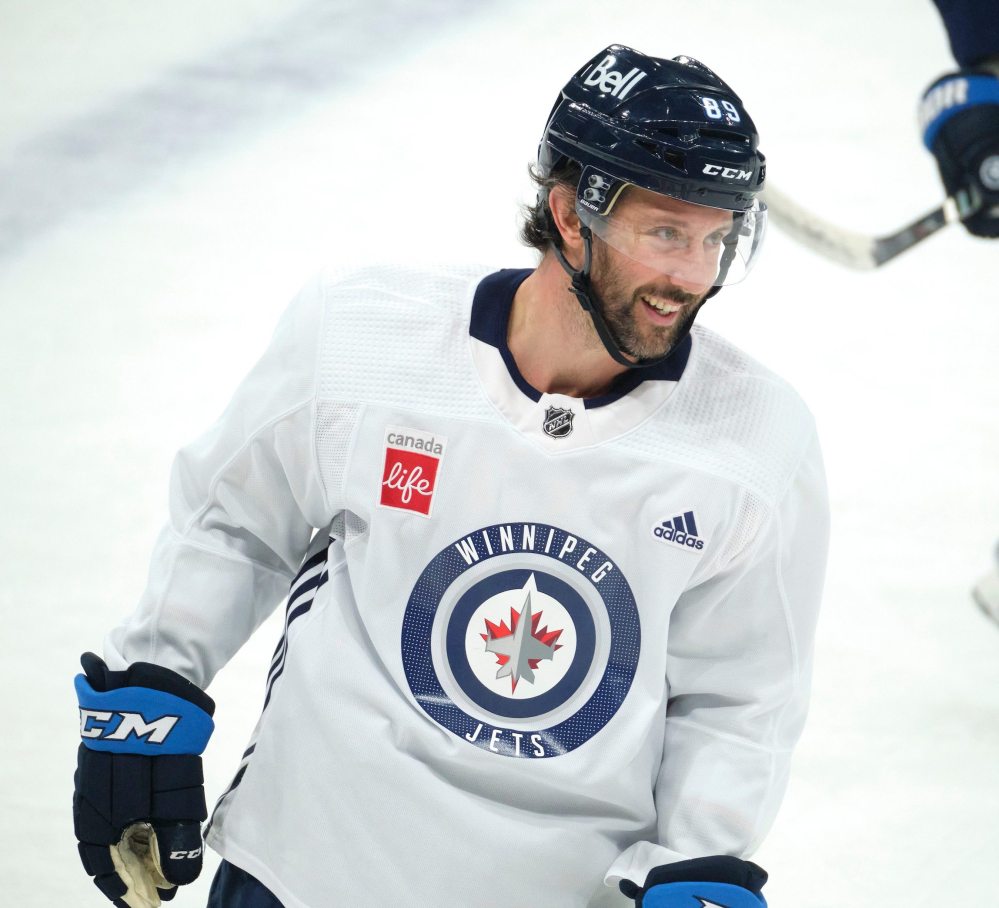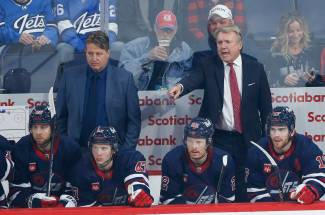Jets pushing each other to be better Healthy competition up and down the roster breeding success
Read this article for free:
or
Already have an account? Log in here »
To continue reading, please subscribe:
Monthly Digital Subscription
$0 for the first 4 weeks*
- Enjoy unlimited reading on winnipegfreepress.com
- Read the E-Edition, our digital replica newspaper
- Access News Break, our award-winning app
- Play interactive puzzles
*No charge for 4 weeks then price increases to the regular rate of $19.00 plus GST every four weeks. Offer available to new and qualified returning subscribers only. Cancel any time.
Monthly Digital Subscription
$4.75/week*
- Enjoy unlimited reading on winnipegfreepress.com
- Read the E-Edition, our digital replica newspaper
- Access News Break, our award-winning app
- Play interactive puzzles
*Billed as $19 plus GST every four weeks. Cancel any time.
To continue reading, please subscribe:
Add Free Press access to your Brandon Sun subscription for only an additional
$1 for the first 4 weeks*
*Your next subscription payment will increase by $1.00 and you will be charged $16.99 plus GST for four weeks. After four weeks, your payment will increase to $23.99 plus GST every four weeks.
Read unlimited articles for free today:
or
Already have an account? Log in here »
Hey there, time traveller!
This article was published 01/12/2022 (1101 days ago), so information in it may no longer be current.
In trying to pinpoint the reasons for the Winnipeg Jets success through the first quarter of the 2022-23 NHL season, there are some obvious factors at play.
The Jets, whose record of 14-6-1 has them one point shy of the Dallas Stars for first place in the Central Division (with two games in hand), have had stellar goaltending from Connor Hellebuyck. The team has also had consistent performances from its other stars, including strong starts from the likes of forwards Mark Scheifele, Pierre-Luc Dubois, Kyle Connor and Blake Wheeler, as well as from a defensive group highlighted by Josh Morrissey, who currently leads the Jets with 25 points.
MIKE DEAL / WINNIPEG FREE PRESS FILES Jets head coach Rick Bowness has created an environment of respect and accountability on his team.
There’s no doubt the addition of head coach Rick Bowness has also played a pivotal role. Bowness has not only brought in new and effective systems for all areas of the ice, his honest and transparent nature has also helped usher in a new culture in the locker room, one built on accountability and respect for one another.
There are other, perhaps less obvious reasons for why the Jets have exceeded expectations so far this year, and they are a byproduct of some of the elements discussed above. Among them is the high level of healthy competition up and down the roster.
While every year brings competition for spots in the lineup, there’s a different feel to this season’s in-house battles compared to previous years. The healthy competition has pushed each player to get better — that’s always the primary goal — but where it differs this season is the competition is being fostered in a much more supportive environment, from a coaching and player standpoint.
“If you watch practice, even today, it’s been high tempo and guys are always competing… With that competition up and down the lineup, everyone’s got a chance to get in and play.”– Jets forward Morgan Barron
“If you watch practice, even today, it’s been high tempo and guys are always competing,” Jets forward Morgan Barron said following Thursday’s workout at the team’s practice facility in Headingley. “With that competition up and down the lineup, everyone’s got a chance to get in and play. I’ve been on the other side of it, sitting out for weeks, and everyone getting to play is probably part of why things are going as smooth as they are here.”
Barron has only been with the Jets since last March, acquired as part of the Andrew Copp trade with the New York Rangers. Albeit a small sample size, the 23-year-old says there’s a noticeable difference from last season to this one when it comes to handling players and the effort being made so everyone feels a part of the club’s success, whether they’re in the lineup or not.
MIKE DEAL / WINNIPEG FREE PRESS FILES The Winnipeg Jets acquired Morgan Barron as part of the Andrew Copp trade with the New York Rangers in March.
With the NHL being a business as much as it is a sport, with millions of dollars at stake, there can often be a clear hierarchy among players. The Jets have had that division in previous years, evident by the fact this season everyone has signed a new creed consisting of four pillars – purpose, integrity, open-handed communication and being like water, with the water signifying a willingness to adapt and be malleable regardless of circumstances.
“I’ve noticed it quite a bit, whether it’s an older guy, younger guy, the guy who plays first line and power play or fourth line and penalty kill, guys just seem to have a cohesiveness this year, just getting along and everyone’s just happy to see each other succeed,” said Barron. “It’s obviously a little bit easier when you’re winning games, but there’s definitely a unique support system for each other.”
“Everyone wants to play more, everyone wants to be in the lineup every night and everyone should push for that. But while pushing for that they should also be trying to help their teammates get better.”–Sam Gagner
Sam Gagner is nearing 1,000 NHL games, having played for seven different teams over a 16-year career, and is on a one-year deal with the Jets. He emphasized the word healthy when asked about the healthy competition brewing within the team, noting the importance of having a strong culture and an encouraging environment in order to maximize those battles for roster spots.
“Everyone wants to play more, everyone wants to be in the lineup every night and everyone should push for that,” said Gagner. “But while pushing for that they should also be trying to help their teammates get better. Ultimately, that’s how you win in this league and we’re fostering that culture in this room.”
MIKE DEAL / WINNIPEG FREE PRESS FILES Veteran forward Sam Gagner has played for seven different NHL teams over his 16-year career.
That culture has empowered the players who are consistently in the lineup, as well as the guys still trying to become everyday NHLers. It’s been particularly beneficial for those that find themselves in and out of games, especially in helping ease the intense pressures — wanting to stick in the NHL and perform well for your teammates — that inevitably come with returning to the lineup.
“You should want to compete for your ice time, compete for your job and you want to be in an environment that allows you to do that and where you can feel good about yourself doing it,” added Gagner. “It’s a big reason for why we’ve had the success we’ve had and even when things don’t go well or as they should, we’ve got to continue to foster that environment.”
Players agree Bowness has been the biggest factor as far as creating a competitive and supportive environment and he’s achieved that, at least in part, by giving them control over the room. He’s also not afraid to hold players accountable, either by moving someone up or down the lineup or outright benching a player if he doesn’t believe the effort is there.
“Comfortable in a pro athlete, that doesn’t work. So, we try to keep that comfort zone a little bit on edge. Even the top end guys, you’ve got to stay on them, too.”–Rick Bowness
You can only pull that off as long as you’re a strong communicator and Bowness is just that. He can be brutally honest and at the same time incredibly supportive. He gives players longer leashes to improve and make up for mistakes and is always clear about his assessment of their play.
It can be a tough balancing act at times.
“Comfortable in a pro athlete, that doesn’t work. So, we try to keep that comfort zone a little bit on edge. Even the top end guys, you’ve got to stay on them, too,” said Bowness.
“There’s an art to this that can never be forgotten, can never be overlooked and that would be the feel of what you’re seeing and how you communicate with your players. Sometimes the X’s and O’s, that’s the easy part of coaching. The hard part is that art part, of how to get along with the players and deal with the players, communicate with the players and relate to them.”
Bowness said another key is for players to resist feeling satisfied and that can include a reminder that while the Jets have had a lot of success this season, they also have a long way to go. It’s also important for players — individually and as a team — to not take anything for granted.
“I want them to want more,” Bowness said. “That ‘more’ comes from the challenge, internally, from internal competition, and that’s a good thing. It can’t be a given: OK I’m on the power play or the penalty kill. It can’t be a given. Those things have got to be earned and you can never take that away from the players.”
Jeff.Hamilton@freepress.mb.ca
Twitter: @jeffkhamilton

Jeff Hamilton
Multimedia producer
After a slew of injuries playing hockey that included breaks to the wrist, arm, and collar bone; a tear of the medial collateral ligament in both knees; as well as a collapsed lung, Jeff figured it was a good idea to take his interest in sports off the ice and in to the classroom.
Our newsroom depends on a growing audience of readers to power our journalism. If you are not a paid reader, please consider becoming a subscriber.
Our newsroom depends on its audience of readers to power our journalism. Thank you for your support.





